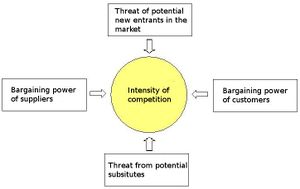Competitive environment
| Competitive environment |
|---|
| See also |
Competitive environment of organization is made up of all competitive or cooperative relationships. Organizations may facilitate the positive or negative (harming) activities towards each another. The competitive environment thus includes suppliers, customers, competitors, associations and chambers of industry, research institutes, clusters, etc.
Competitive Analysis
The purpose of the analysis of the competitive environment is:
- Estimate the attractiveness of the sector for companies that already operate in it, and for the new entrants or investors,
- Determine the prospects of individual sectors, opportunities and threats
- Definition of new, attractive sectors for the company in which it could invest.
One method of competitive analysis is Porter's concept of five competitive forces. According to Porter the company's position in the market and the attractiveness of the market is determined by five factors:
- Threat of new competitors- is high, provided that the sector is economically attractive (large and increasing, profitable) while barriers to entry to the sector are not too high,
- Bargaining power of suppliers - is expressed in the possibility of raising prices or lowering quality of supplied raw materials, which in turn causes an increase in the cost of the company,
- Bargaining power of buyers- has a very large impact on the overall market situation and the situation of a particular company. IT is associated with the effectiveness of creating pressure on increasing quality of the products, lowering prices and increasing quality of services,
- Availability of substitutes - is connected with the possibility of substitution on the market. It automatically decreases the attractiveness of the industry, which is why the company should understand what is and what can become a substitute for its products and who is the real competitor of the company,
- The intensity of competition in the industry- mainly related to area of pricing, distribution, promotion and characteristics of the product itself and related services. Competition can be a threat to both the company's position in the sector and an opportunity to achieve competitive advantage, according to Porter competition in the market increases when companies see a chance to improve its market position.
Rating the attractiveness of the sector is based here on characterizing the formation of each of the forces and determine what opportunities and threats are associated with them. he lower the risk of emergence of new producers, the smaller is the importance of substitutes and less severe competitive struggle between the participants in the sector.
See also:
References
- Porter, M. E. (2008). Competitive strategy: Techniques for analyzing industries and competitors. Simon and Schuster.
- Porter, M. E. (1998). Cluster and the new economics of competition.
- Porter, M. E. (1991). Towards a dynamic theory of strategy. Strategic management journal, 12(S2), 95-117.
- Porter, M. E., & Van der Linde, C. (1995). Toward a new conception of the environment-competitiveness relationship. The journal of economic perspectives, 9(4), 97-118.
